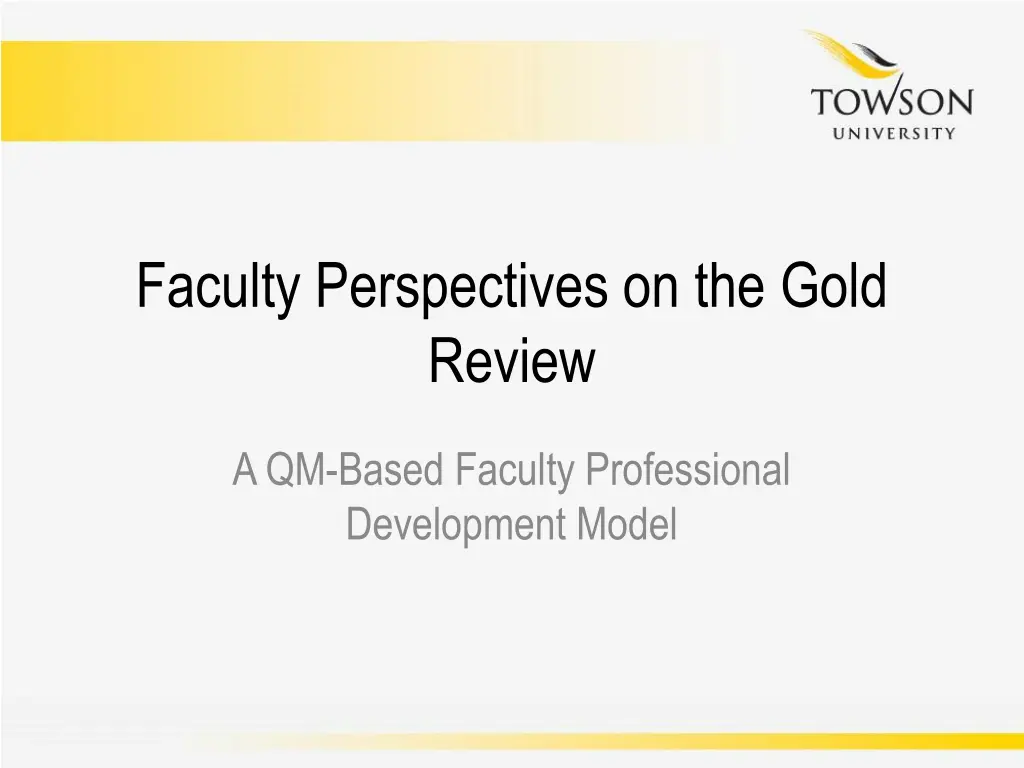
Insights into Faculty Perspectives on Gold Review Process
Explore faculty perspectives on the Gold Review, a QM-based faculty professional development model. Discover session objectives, challenges in scaling faculty participation, the Gold Review process, accomplishments to date, undergraduate and graduate courses reviewed, and insights from Assistant Professor Bethany Willis Hepp on motivations and improvements made.
Download Presentation

Please find below an Image/Link to download the presentation.
The content on the website is provided AS IS for your information and personal use only. It may not be sold, licensed, or shared on other websites without obtaining consent from the author. If you encounter any issues during the download, it is possible that the publisher has removed the file from their server.
You are allowed to download the files provided on this website for personal or commercial use, subject to the condition that they are used lawfully. All files are the property of their respective owners.
The content on the website is provided AS IS for your information and personal use only. It may not be sold, licensed, or shared on other websites without obtaining consent from the author.
E N D
Presentation Transcript
Faculty Perspectives on the Gold Review A QM-Based Faculty Professional Development Model
Session Objectives Share how the Gold Review process has progressed since its inception in 2015 Hear faculty perspectives as Peer certified reviewers Review Team members Brainstorm ways to scale up and sustain the model in order to keep faculty learning at the forefront
Thought Question What is the biggest challenge to SCALING UP faculty participation in the review process?
VIDEO Background Towson University, a master s comprehensive state university within the University System of Maryland
Gold Review Process A comprehensive course review and instructional design support system based on QM standards Teams of QM-certified faculty reviewers and Office of Academic Innovation instructional designers use an abridged version of the QM Rubric to review courses Formative, not evaluative Not a teaching evaluation
Accomplishments to Date Faculty Participants (n = 21) Courses Reviewed (n = 19)
Undergraduate Courses (n = 10) AHLT 310 AHLT 320 AHLT 450 MUSC 116 MUSC 355 HLTH 207 HLTH 220 KNES 315 KNES 460 HCMN 441
Graduate Courses (n = 9) ILPD 603 ILPD 668 ILPD 675 ILPD 716 ILPD 740 ILPD 742 ILPD 745 ILPD 781 ILPD 797
Bethany Willis Hepp, Ph.D. Assistant Professor Family Studies and Community Development Motivation to Participate As a Reviewer: Desire to increase my knowledge base about online learning Wanted inter-disciplinary perspectives on distance learning Looking for best-practices As a Participant: Desire for constructive peer-feedback on a course were I was feeling too comfortable Desire to increase student ownership of the learning experience while supporting their process with quality supports in an online forum Improvements Made In distance courses AND face-to-face courses: Increased navigability Increased student-to-student, student- to content, and student-to-instructor engagement Increased Universal Design, easing burden for students with varied learning styles in an online format Outcomes reflect differences based on qualitative feedback from student evaluations over time!
Linda Caplis, Clinical Assistant Professor Allied Health Program, Towson University--- The only online undergraduate program at TU - QM provided professional development to become competent as online instructor - Online can be more robust than face-to-face learning BUT IT TAKES TIME, ENERGY, & SUPPORT - QM Standards applicable to face-to-face teaching - ALIGNMENT, ALIGNMENT, ALIGNMENT
Mickey Jancewski Department of Health Science Full time Lecturer, College of Health Professions Peer reviewer, training to chair course reviews Why? Learning Platforms/courses should be easy to use Student learning Professional growth Course changes? Organization and structure Student engagement More diverse learning materials




